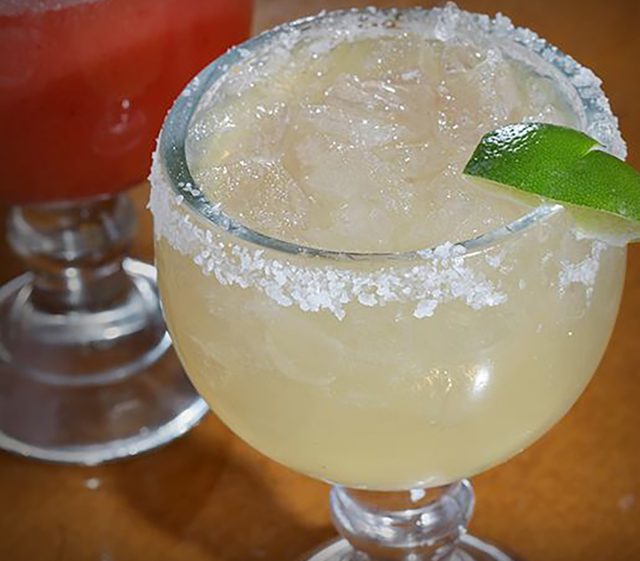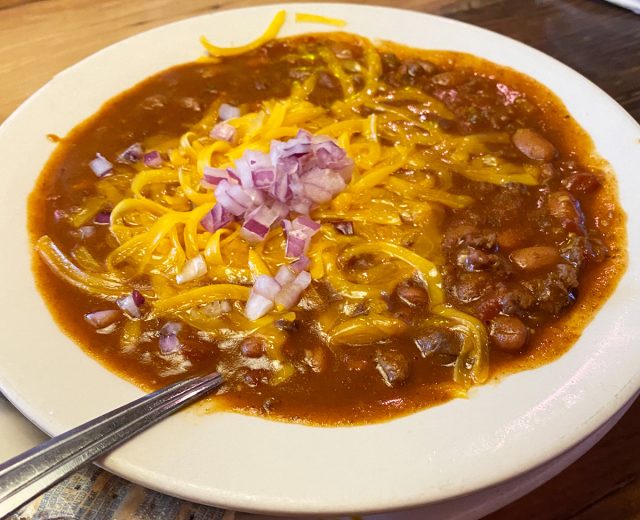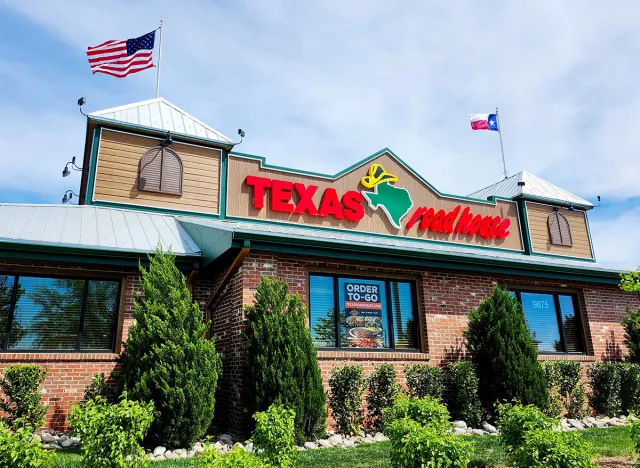9 Texas Roadhouse Facts That Are Juicier Than Its Steaks

Since bursting onto the scene in 1993, Texas Roadhouse has steadily grown into America’s most iconic restaurant brand. Beloved for its laid-back, honky-tonk vibe as much as its juicy, hand-cut steaks, the western-themed restaurant chain continues to draw crowds even despite recent price hikes.
With rising sales figures and an ever-expanding store count, the Kentucky-based outfit now appears poised to inevitably overtake Olive Garden as the nation’s top-selling restaurant chain—an impressive feat, especially when you consider that Roadhouse has roughly 300 fewer company-owned locations.
Before his untimely death in 2021, Texas Roadhouse founder Kent Taylor authored a book about his long, winding path to success, titled “Made From Scratch.” The colorfully written, 320-page memoir contains many insightful anecdotes and revelations about the chain’s original vision, early struggles, and eventual triumphs.
If you’re curious about how or why the popular steakhouse chain operates the way it does, you’ll find many of the answers in Taylor’s book.
Here are several interesting takeaways about the rise of Texas Roadhouse, straight from the celebrated founder’s own words.
It rose from the ashes of other struggling chains.

Founder Kent Taylor, aka “Bubba” to his friends and colleagues, was a service-industry journeyman who previously worked for several other restaurant chains, including Hooters, KFC, and Bennigan’s. In his book, Taylor described Bennigan’s as “hip and happening” when he joined the company back in the 1980s. At its height, the Irish-themed chain boasted some 300 restaurants nationwide. It’s now down to less than two dozen.
Taylor disliked a lot of things about the buttoned-up corporate culture at Bennigan’s, which inspired him to rip off his restrictive necktie and start his own restaurant company—”so I would never have to work for someone else again,” he wrote.
Many of the folks that Taylor recruited to help him build the Roadhouse business came from either Bennigan’s or the Mexican-themed Chi-Chi’s, another once-celebrated restaurant chain that ultimately fell on hard times. Lawyers for Bennigan’s even threatened legal action over Taylor’s efforts to poach its employees, he wrote.
Roadhouse also benefited from the decline of an older casual-style steakhouse chain: California-based Sizzler. One of the earliest Roadhouse locations was a failing Sizzler in Kentucky. The operator was “willing to throw some money our way to try something new,” Taylor wrote. Soon, other Sizzler managers started reaching out to convert their restaurants into Roadhouses, too.
“Between the Sizzler remodels and attracting many Chi-Chi’s folks, I was well on my way to systematically eliminating crappy food from the American palate,” Taylor quipped.
It originally featured live music.

Taylor described his initial vision for the restaurant as combining a “rough and somewhat rowdy live music joint with a reasonably priced restaurant featuring steaks and ribs.” In fact, the first Roadhouse location in Indiana included a stage for country music bands to perform. Taylor wrote that he planned to have bands playing every night, but after dealing with musicians “showing up late, playing too loud, or going too long,” he decided to pull the plug on live music altogether. Henceforth, no other Roadhouse location would provide a stage for live performances.
It originally served Mexican food.

Beyond steaks and ribs, the original Roadhouse also offered other fare, including (of all things) Mexican dishes. That’s due to the Chi-Chi’s influence. With their backgrounds in south-of-the-border-style cuisine, two early Roadhouse managers insisted on having a Mexican section on the menu. Though Taylor agreed to try it, the effort was short-lived. “Our kitchen wasn’t set up to do Mexican food justice,” he wrote. “With poor execution and almost no sales, we eliminated the Mexican items two weeks after opening.”
At least one Mexican-inspired touch would stick, however: the chain’s signature cocktail—its “legendary margarita.” Roadhouse now offers 15 different varieties of the classic tequila cocktail.
It was sly about its Texas connections.

While conceived in the image of a “rowdy roadhouse out in the hill country of Texas,” Taylor’s upstart restaurant company had no actual roots in the southwestern state—much like its rival Outback Steakhouse had no real connection to Australia. A true Texan would know this by taking one look at the restaurant’s “Texas Red Chili,” which noticeably contains beans—a clear faux pas in the land of stetsons and longhorns.
In fact, it took several years before Taylor & Co. even opened a single location in the Lone Star State. Yet, in the early days, Taylor did little to dissuade patrons from thinking otherwise. In the book, he revealed that comment cards left on tables for customer feedback were intentionally addressed to a post-office box in Dallas “to make people believe we were located in the Lone Star State.” The cards would then be forwarded to the company’s real headquarters in Louisville.
Three of the first five restaurants failed.

It’s hard to imagine now, as the chain continues to see record sales and aims for wider expansion, but the Roadhouse business wasn’t always booming. The first two locations were profitable. The next three were not. Two of the misfires were located in touristy Florida towns, where sales rose and fell with the ebb and flow of out-of-towners. The other underperforming restaurant was located in what Taylor described as a “lousy” part of Cincinnati. All three amounted to poor real estate decisions. “I have mementos on the wall of my office from each of those three stores, reminding me of the people affected by their failure, the money lost, and the lessons learned,” Taylor wrote.
The buildings have towers for a reason.

Texas Roadhouse restaurants have a distinctive look that sets them apart from other chains. One defining architectural feature is the pair of towers that grace the roofs of most locations. The tower aesthetic dates back to the chain’s second restaurant in Gainesville, Fla. In his book, Taylor explained that the landlord of that site was “very particular” and specifically required the restaurant to have a tower on the building.
Taylor liked the tower look so much that he eventually decided that one wasn’t enough. Nowadays, most locations have two towers. Superstition is at least part of the reason. All three of Roadhouse’s early underachieving locations featured only a single tower. “Logical conclusion: add a second tower,” Taylor wrote.
You may also notice that the grounds of your local Roadhouse look more lush than the lots surrounding most restaurant chains. The attention to landscaping is another detail that Taylor picked up from the same Florida landlord.
The logo was a late-night revelation.

Taylor drafted the restaurant’s iconic logo himself—but didn’t really remember doing so. The design, which features a cowboy hat perched atop the Texas panhandle and vintage-style neon letters, was doodled on a cocktail napkin that he found stuffed in his pocket after being “overserved” at a local bar the night before. “Everything about it spoke to comfort food and old-fashioned fun,” Taylor wrote. “Plus, it had the added dramatic value of being drafted on a friggin’ cocktail napkin late one night in a bar where nobody knows your name.”
Every restaurant has its own unique artwork.

With its sixth location in Lexington, Ky., Texas Roadhouse began a now-longstanding tradition of outfitting every restaurant with eye-catching murals. Approached by a local artist rep, Taylor became especially fond of a Native American portrait by Kentucky artist David Carter. A self-described fan of Native American culture, Taylor would later hire Carter to paint for Roadhouse exclusively, according to the book. By 2021, Carter’s studio had produced over 3,500 murals for the restaurant chain.
To this day, original artwork remains an integral part of the Roadhouse aesthetic. According to the chain, new murals are created “specifically for each restaurant” and “designed to reflect the local community.” Every restaurant also displays one of several portraits of an “older, distinguished Native American” from Carter’s studio.
Big-name investors balked—except for one.

In the beginning, Taylor tried to wrangle investments from several celebrities, including singer Garth Brooks, basketball legend Larry Bird, and one-time presidential candidate Ross Perot. But the one he ended up with was probably a better fit for Roadhouse’s easy-going sensibilities—country music icon Willie Nelson.
The pair initially linked up through a bourbon company that wanted to sell Nelson’s spirit brand, Old Whiskey River, in Taylor’s restaurants. The details of how that relationship evolved are sort of hazy in the book—which is often the case when dealing with the legendary “Red Headed Stranger”—but the singer would ultimately perform at the company’s annual conference and sign autographs for fans at Roadhouse restaurants as he toured the country. He also promoted the chain in radio and TV appearances.
In the book, Taylor described Nelson as a “core partner of our company” and “my favorite poker buddy.” In 2004, Nelson partnered up with Texas Roadhouse to open two new restaurants in Austin, Texas. “The portion of the restaurants that he owned may have increased by as much as 5 percent as a result of some really bad poker playing by yours truly,” Taylor wrote.
Every Roadhouse restaurant now includes an area called “Willie’s Corner,” adorned with memorabilia in honor of the singer. Nelson even contributed a blurb to Taylor’s book, describing the Roadhouse founder as “a great friend” and writing, “I felt we could work together because the company held the values I believe in… and the food was great!”